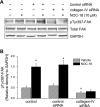Collagen IV contributes to nitric oxide-induced angiogenesis of lung endothelial cells
- PMID: 21307347
- PMCID: PMC3093940
- DOI: 10.1152/ajpcell.00368.2010
Collagen IV contributes to nitric oxide-induced angiogenesis of lung endothelial cells
Abstract
Nitric oxide (NO) mediates endothelial angiogenesis via inducing the expression of integrin α(v)β(3). During angiogenesis, endothelial cells adhere to and migrate into the extracellular matrix through integrins. Collagen IV binds to integrin α(v)β(3), leading to integrin activation, which affects a number of signaling processes in endothelial cells. In the present study, we evaluated the role of collagen IV in NO-induced angiogenesis. We found that NO donor 2,2'-(hydroxynitrosohydrazino)bis-ethanamine (NOC-18) causes increases in collagen IV mRNA and protein in lung endothelial cells and collagen IV release into the medium. Addition of collagen IV into the coating of endothelial culture increases endothelial monolayer wound repair, proliferation, and tube formation. Inhibition of collagen IV synthesis using gene silencing attenuates NOC-18-induced increases in monolayer wound repair, cell proliferation, and tube formation as well as in the phosphorylation of focal adhesion kinase (FAK). Integrin blocking antibody LM609 prevents NOC-18-induced increase in endothelial monolayer wound repair. Inhibition of protein kinase G (PKG) using the specific PKG inhibitor KT5823 or PKG small interfering RNA prevents NOC-18-induced increases in collagen IV protein and mRNA and endothelial angiogenesis. Together, these results indicate that NO promotes collagen IV synthesis via a PKG signaling pathway and that the increase in collagen IV synthesis contributes to NO-induced angiogenesis of lung endothelial cells through integrin-FAK signaling. Manipulation of collagen IV could be a novel approach for the prevention and treatment of diseases such as alveolar capillary dysplasia, severe pulmonary arterial hypertension, and tumor invasion.
Figures









Comment in
-
Nitric oxide-induced collagen IV expression and angiogenesis: FAK or fiction? Focus on "Collagen IV contributes to nitric oxide-induced angiogenesis of lung endothelial cells".Am J Physiol Cell Physiol. 2011 May;300(5):C968-9. doi: 10.1152/ajpcell.00059.2011. Epub 2011 Mar 9. Am J Physiol Cell Physiol. 2011. PMID: 21389280 Free PMC article. No abstract available.
References
-
- Babaei S, Stewart DJ. Overexpression of endothelial NO synthase induces angiogenesis in a co-culture model. Cardiovasc Res 55: 190–200, 2002 - PubMed
-
- Ferrara N, Gerber HP. The role of vascular endothelial growth factor in angiogenesis. Acta Haematol 106: 148–156, 2001 - PubMed
-
- Frelin C, Ladoux A, D'Angelo G. Vascular endothelial growth factors and angiogenesis. Ann Endocrinol (Paris) 61: 70–74, 2000 - PubMed
Publication types
MeSH terms
Substances
Grants and funding
LinkOut - more resources
Full Text Sources
Molecular Biology Databases
Miscellaneous

